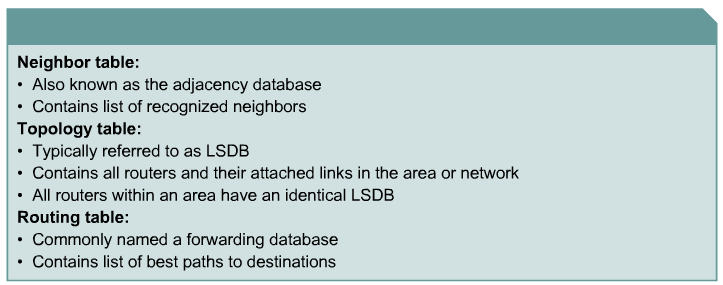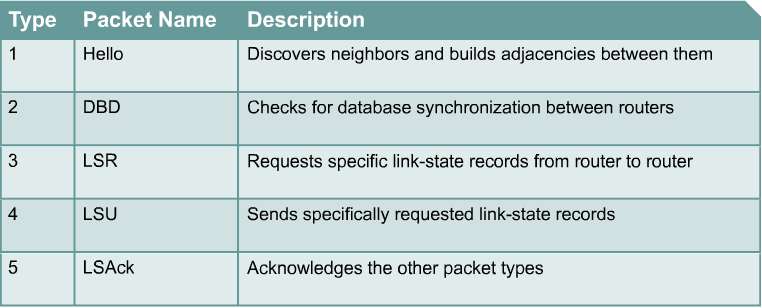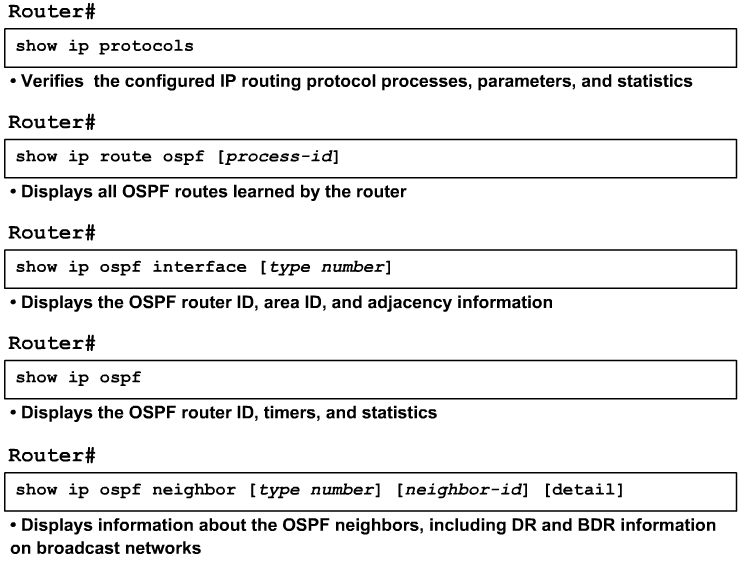Pederrs CCNP 1
Contents
- 1 Module 1: Scalable Network Design
- 2 Module 2: EIGRP
- 3 Module 3: OSPF
- 3.1 Forkortelser:
- 3.2 Teori
- 3.2.1 3.1.1 Link State Routing Protocols
- 3.2.2
- 3.2.3 3.1.3 Link State Data Structures
- 3.2.4 3.1.6 Types of OSPF Routers
- 3.2.5 3.1.9 Link-State Data Structures
- 3.2.6 3.2.1 OSPF Packet Types
- 3.2.7 3.2.2 OSPF Packet Header Format
- 3.2.8 3.3.4 Configuring a Router ID
- 3.2.9 Verifying the OSPF Operation
- 3.2.10 3.6.3 OSPF LSA Types (cont.)
- 4 Module 4: Integrated IS-IS
- 5 Module 5: Route Optimization
- 6 Module 6: BGP
- 7 Module 7: IP Multicasting
- 8 Module 8: IPv6
Module 1: Scalable Network Design
Forkortelser:
ECNM = Enterprise Composite Network Model
NAC = Network Access Control (NAC) and
IBNS = Identity Based Network Services (IBNS)
Module 2: EIGRP
Forkortelser:
DUAL = Diffusing Update Algorithm (DUAL)
PDM = Protocol-dependent modules (PDMs) are responsible for network layer protocol-specific requirements. EIGRP supports IP,AppleTalk, and Novell NetWare. Each protocol has its own EIGRP module and operates independently from any of the others that may be running.
RTP = RTP is responsible for guaranteed ordered delivery and reception of EIGRP packets to all neighbors. RTP supports intermixed transmission of multicast and unicast packets. For efficiency, only certain EIGRP packets are transmitted reliably.
SRTT = (smoothed round-trip time): Average number of milliseconds it takes for an EIGRP packet to be sent to this neighbor and for the local router to receive an acknowledgment of that packet. This timer determines the retransmit interval, also known as the retransmission timeout (RTO).
RTO = (retransmission timeout): Amount of time, in milliseconds, that the router waits for an acknowledgment before retransmitting a reliable packet from the retransmission queue to a neighbor. If an EIGRP update, query, or reply is sent, a copy of the packet is queued. If the RTO expires before an acknowledgment is received, another copy of the queued packet is sent.
SIA = stuck in active (SIA)
LSDB = link-state database (LSDB)
SPF = Shortest Path First (SPF)
Module 3: OSPF
Forkortelser:
Teori
3.1.1 Link State Routing Protocols
3.1.3 Link State Data Structures
3.1.6 Types of OSPF Routers
The four different types of OSPF routers are:
- Internal routers: Routers that have all their interfaces in the same area and have identical LSDBs.
- Backbone routers: Routers that sit on the perimeter of the backbone area and have at least one interface connected to area 0. Backbone routers maintain OSPF routing information using the same procedures and algorithms as internal routers.
- Area border routers: Routers that have interfaces attached to multiple areas, maintain separate LSDBs for each area to which they connect, and route traffic destined to or arriving from other areas. Area border routers (ABRs) are exit points for the area, which means that routing information destined for another area can get there only via the ABR of the local area. ABRs can be configured to summarize the routing information from the LSDBs of their attached areas. ABRs distribute the routing information into the backbone. The backbone routers then forward the information to the other ABRs. In a multiarea network, an area can have one or more ABRs.
- Autonomous System Boundary Routers: Routers that have at least one interface attached to an external internetwork (another autonomous system), such as a non-OSPF network. Autonomous system boundary routers (ASBRs) can import non-OSPF network information to the OSPF network and vice versa; this process is called route redistribution.
3.1.9 Link-State Data Structures
When each router receives the LSU, it does the following:
- If the LSA does not already exist, the router adds the entry to its LSDB, sends a link-state acknowledgment (LSAck) back, floods the information to other routers, runs SPF, and updates its routing table.
- If the entry already exists and the received LSA has the same sequence number, the router ignores the LSA entry.
- If the entry already exists but the LSA includes newer information (it has a higher sequence number), the router adds the entry to its LSDB, sends an LSAck back, floods the information to other routers, runs SPF, and updates its routing table.
- If the entry already exists but the LSA includes older information, it sends an LSU to the sender with its newer information
3.2.1 OSPF Packet Types
The OSPF protocol exchanges five packet types:
- Hello
- Database description (DBD)
- Link-state request (LSR)
- Link-state update (LSU)
- Link-state acknowledgement (LSAck)
3.2.2 OSPF Packet Header Format
All five OSPF packets are encapsulated directly into an IP payload, as shown in Figure . The OSPF packet does not use TCP or User Datagram Protocol (UDP). OSPF requires a reliable packet transport scheme. Since TCP is not used, it has defined its own acknowledgment routine that uses an acknowledgment packet (OSPF packet type 5).
In the IP header, a protocol identifier of 89 defines all OSPF packets. Each of the OSPF packets begins with the same header format. This header has the following fields:
- Version number: For OSPF version 2 or 3
- Type: Differentiates the five OSPF packet types
- Packet length: Length of packet in bytes
- Router ID: Defines which router is the source of the packet
- Area ID: Defines the area where the packet originated
- Checksum: Used for packet-header error detection to ensure that the OSPF packet was not corrupted during transmission
- Authentication type: An option that specifies either no authentication, clear-text passwords, or encrypted Message Digest 5 (MD5) formats for router authentication
- Authentication: Used in the authentication scheme
- Data (for hello packet): Includes a list of known neighborsData (for DBD packet): Contains a summary of LSDB, which includes all known router *IDs and their last sequence number, among a number of other fields
- Data (for LSR packet): Contains the type of LSU needed and the router ID that has the needed LSU
- Data (for LSU packet): Contains the full LSA entries; multiple LSA entries can fit in one OSPF update packet
- Data (for LSAck packet): Is empty
3.3.4 Configuring a Router ID
Verifying the OSPF Operation
3.6.3 OSPF LSA Types (cont.)
Type 1 Every router generates router link advertisements for each area to which it belongs. A type 1 LSA describes the collective states of the directly connected links (interfaces) of the router. These LSAs are flooded only within the area in which they are originated.
Type 2 A type 2 LSA is generated for every transit broadcast and NBMA network within an area. A transit network has at least two directly attached OSPF routers. Ethernet is an example of a transit network.
The DR of the network is responsible for advertising the network LSA. A type 2 network LSA lists each of the attached routers that make up the transit network, including the DR itself, as well as the subnet mask used on the link. The type 2 LSA then floods to all routers within the transit network area. Type 2 LSAs never cross an area boundary. The link-state ID for a network LSA is the IP interface address of the DR that advertises it.
Type 3 The ABR sends type 3 summary LSAs. Type 3 LSAs advertise any networks owned by an area to the rest of the areas in the OSPF autonomous system, as shown in Figure .
The link-state ID is set to the network number; the mask is also advertised.
By default, OSPF does not automatically summarize groups of contiguous subnets or summarize a network to its classful boundary. The network operator uses configuration commands to specify how the summarization occurs. By default, a type 3 LSA is advertised into the backbone area for every subnet defined in the originating area, which can cause significant flooding problems. Consequently, you should always consider using manual route summarization at the ABR.
Summary LSAs are flooded throughout a single area only, but are regenerated by ABRs to flood into other areas.
Note By default, summary LSAs do not contain summarized routes.
Type 4
A type 4 summary LSA is generated by an ABR only when an ASBR exists within an area. A type 4 LSA identifies the ASBR and provides a route to it. The link-state ID is set to the ASBR router ID. All traffic destined to an external autonomous system requires routing table knowledge of the ASBR that originated the external routes.
In Figure , the ASBR sends a type 1 router LSA with an external bit (e bit) that is set to identify itself as an ASBR. When the ABR, which is identified with a border bit (b bit) in the router LSA, receives the type 1 LSA, it builds a type 4 LSA and floods it to the backbone (area 0). Subsequent ABRs regenerate a type 4 LSA to flood into their areas.
Type 5 Type 5 external LSAs describe routes to networks outside the OSPF autonomous system. Type 5 LSAs are originated by the ASBR and are flooded to the entire autonomous system.
The link-state ID is the external network number. Because of the flooding scope, and depending on the number of external networks, the default lack of route summarization can be a major issue with external LSAs. Therefore, you should summarize blocks of external network numbers at the ASBR to reduce flooding problems.
Type 6 Type 6 LSAs are specialized LSAs that are used in multicast OSPF applications.
Type 7 Type 7 is an LSA type that is used in not-so-stubby areas (NSSAs). They are originated by ASBRs within NSSAs and are flooded only within the NSSA in which they originated.
Type 8 Type 8 is a specialized LSA that is used in internetworking OSPF and Border Gateway Protocol (BGP).
Types 9, 10, and 11 The opaque LSAs, types 9, 10, and 11, are designated for future upgrades to OSPF for application-specific purposes. For example, Cisco Systems uses opaque LSAs for Multiprotocol Label Switching (MPLS) with OSPF. Opaque LSAs are distributed using standard LSDB flooding mechanisms. Each type has a different flooding scope.







